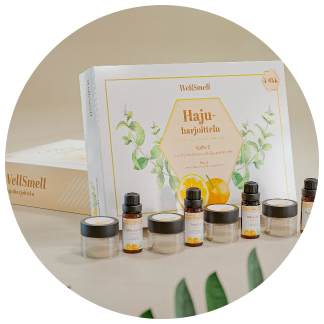WellSmell smell training
People who have lost all or part of their sense of smell can rehabilitate it through regular smell training. We offer a ready-to-use product package for smell rehabilitation.
Limited availability
We currently ship smell training products to customers in Finland and Sweden, and hope to serve the rest of the EU in the near future. Contact customer services at info@wellsmell.fi to ask about schedules.
Smell training
Our smell training product is not medicine, but rather a medical device that will guide your rehabilitation. With smell training, you can speed up and promote the recovery of your sense of smell.
Our products are aimed at people who have partial or total loss of sense of smell due to olfactory dysfunction. Scientific studies have shown that smell training has a positive effect on the development of a person’s sense of smell.
Three-phase training
The training includes three phases, and each phase lasts three months. The training starts with the starter kit, from which you move on to the following training phases.
Our products are carefully selected, pure, natural, high-quality oils with no synthetic ingredients. Our essential oils are made from the flowers, fruits, leaves, roots, and resin of plants containing aromatic substances.
In our online store, you can order the WellSmell small training kits.

Start on time
We recommend starting your smell training as soon as possible after the loss of smell, as studies have shown that starting promptly after the loss of smell improves and speeds up the recovery of the sense of smell in some patients. Smell training should be started within one year of the loss of smell, but even after more than a year, it can be beneficial.
Hajuharjoittelu olisi hyvä aloittaa vuoden sisällä hajukyvyn menetyksestä, mutta jopa yli vuoden kuluttua aloitettu harjoittelu saattaa olla hyödyllistä.
Sense of smell may develop for a long time
Go through all the phases, as the process of improving your smell takes a long time and requires persistent training. Sense of smell can still improve 2 to 3 years after it has been lost.
Each of our smell training products contains four carefully selected scents. These scents form a group of odours that stimulate the olfactory part of the brain. An odour group is also called an odour prism.
How should I train?
Allow enough time for training. The best results are achieved when you are mentally relaxed and focused on your training. Perform the exercise twice a day, in the morning before breakfast and in the evening before going to bed.
Place the jar in front of your face near your nose. Smell each scent for 10 seconds, pause for 10 seconds and then move on to the next scent. After you have smelled all four scents, repeat the exercise one more time. You can find more detailed training instructions in the product kits.
Product guide video

What causes loss of smell?
Total or partial loss of smell can be due to a variety of reasons. Some people lose their sense of smell due to injuries such as falls, others due to a viral upper respiratory tract infection (e.g., Covid-19 coronavirus infection), and others due to other, less common or even unexplained causes. The deterioration or loss of smell can also be caused by nasal polyps or ageing.

Scientific studies on smell training
In 2009, Professor Thomas Hummel from the University of Dresden started a study to find out whether daily, strong scents of different odours have a positive effect on a person’s sense of smell. The study lasted 12 weeks and was carried out in a group of people with anosmia, “smell blindness”. These people had all lost their sense of smell due to head injuries, severe upper respiratory tract infections, or other, unexplained causes.

